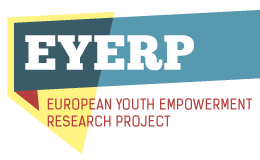 We believe that empowerment is a crucial aspect of youngsters’ self realization process, which can help them shape their future and their world. Youth workers and practitioners, in that sense, are in the best position to support youngsters and their endeavors in order to make this happen. Therefore, the main goal of this User’s Guide is to share resources and tools with you, which could be used in your daily work and support you in your efforts.
We believe that empowerment is a crucial aspect of youngsters’ self realization process, which can help them shape their future and their world. Youth workers and practitioners, in that sense, are in the best position to support youngsters and their endeavors in order to make this happen. Therefore, the main goal of this User’s Guide is to share resources and tools with you, which could be used in your daily work and support you in your efforts.
In order to better understand the results and improve the ways you measure your outcomes, here we present the tools that can help you evaluate and analyze your work, as well as examine its’ actual effects in a consistent manner.
Therefore, the Questionnaire can help you recognize and document youngsters’ potentials and their development. The tools are meant to provide you with unique information, in addition to your actual observation. And that would enable you to better adapt your work to a specific youngster, to know more about them or have a clearer view of the impact of your activities, and – last but not least – to involve youngsters. It records the intentions of the youngster to put ideas into action, which is an essential connection between Empowerment, Entrepreneurship, and Participation. It will also enable you to follow the youngsters over a certain period of time, where you can evaluate your work and see whether certain activities benefit the youngsters or not.

Photo credit: Plattform e.V.
Target group: Youngsters, 15 years and older. It might be too difficult with youngsters below 15 years.
Time needed: Usually it takes 5 to 10 minutes to edit the Questionnaire. If you want to use it for more complex issues you might need more time. Time for preparation, analysis and interpretation might vary depending on the particular interest of the user.
Resources needed: The questionnaire and a pen, or a digital document with appropriate equipment, and a comfortable atmosphere. Something that can be used as a reward, like cookies and sweets. Analysis can be supported by us.
Outcomes: Working with the Questionnaire enables you to:
1) see the concrete intention of the youngster to put ideas into action and its’ direct sources
2) measure the attitude
3) analyze the subjective normative beliefs
4) assess the perceived control over putting ideas into action.
First of all, there is no need for an extra training or expert support to use our questionnaire effectively. Every skilled youth worker should be able to use it properly. Therefore, all you need is a copy of the questionnaire printed for every youngster, or an access to the online version for everyone. In line with that, you should prepare an appropriate setting, which can facilitate the process further, i.e. a quiet, comfortable room with some cookies. Cookies are not very necessary, although anything rewarding and motivating should be there.
When everything is ready and all the participants are there, you can explain the youngsters about the questionnaire and what will happen with their answers. Their answers may help you improve your work, and of course, the youngsters would benefit from this as well. But this mutual benefit may only work if their answers are honest and accurate. Therefore, please make it clear that all the answers are confidential and no one will be judged or face restrictions based on their answers. All answers must be given voluntarily.

Photo credit: Plattform e.V.
After that, questionnaire materials can be distributed to participants. We suggest that the organizers should create a relaxed and peaceful atmosphere while completing the questionnaire. Obviously, youngsters can act freely, i.e. talk, eat, ask questions, as long as it helps them and nobody gets distracted. It usually takes 5 to 10 minutes to complete the questionnaire. If it takes longer than that, you may ask if the- re is a problems and offer your support. You will find many interesting insights to your work while going through their answers. But in order to see the full picture the analysis model needs to be completed and processed. The data processing will be done automatically if you use the online version of the questionnaire model. Otherwise, all answers have to be transferred first into our online analysis spreadsheet form. You can send us the spreadsheet or the digital version of the data, if you need help with the analysis. The analysis will provide you with an actual estimate of the individual’s most important preconditions to putting ideas into practice, namely: the intention to do so, the attitude and perceived social norm toward that activity, and the perceived ability to perform and control it.
The more youngsters participate in the Questionnaire, the better chances you have to improve the quality of the data and analysis. You can further enhance the quality of data by carrying out the survey several times over a certain period of time. This will give an additional information and enable you to compare the results with previous survey data, and measure the development of youngsters. You can also estimate the immediate impact of a method, which you have tested with youngsters, by carrying out the survey directly before and after the implementation of the method.
The final step in this process is the interpretation of data and analysis. This is where you need to rely on your own skills and expertise. If you know what you what to achieve, your goals, conditions, and participants who took the questionnaire, then the interpretation will be easier for you. Set the results in the right frame before you evaluate them. And then, try to find the most promising reasons and conclusions to your outcomes. When you come to your conclusions, make sure to keep your questionnaire beside you, so that you can evaluate your conclusions as well.
We developed this questionnaire by building on a sophisticated proven model and with the help of colleagues, scientists, and more than 250 youngsters. It is the result of testing several versions, extensive feedbacks, tests and a collection of best questions.

Photo credit: Plattform e.V.
The model we used was introduced by Icek Ajzen in 1985. It sets out the most direct sources for individual planned action, i.e. why somebody does as intended or not. He states that planned action rests on the intention to do so and the individual control over the actual situation. Hence, the proximal causes of the behavior intention are the individual’s attitude, and subjective norms towards that planned action, as well as the perceived control over it.
The information provided by the individual is strictly confidential. However, general results and outcomes of the survey can be shared and used for documentation purposes, as well as for reflection of your work and for making a better decisions in the future. In any case, the meaning of the outcome is a matter of interpretation and not calculation. We would recommend you to discuss the results with youngsters who took the survey and colleagues to derive practical insights and outputs.
You can download the full version of the Questionnaire in English language here:
You can download the full version of the Competence Reflection sheet in English language here:

